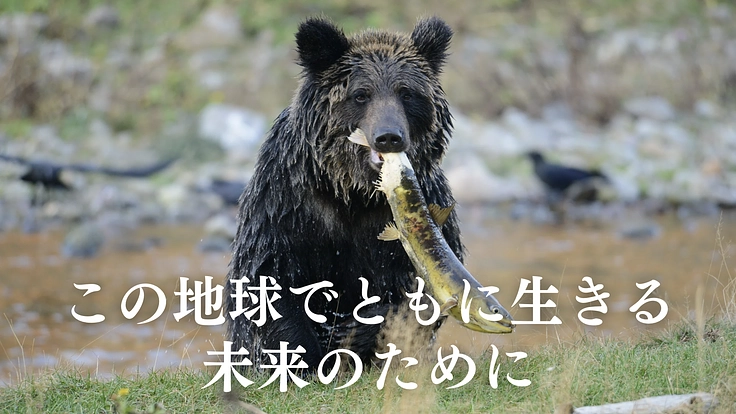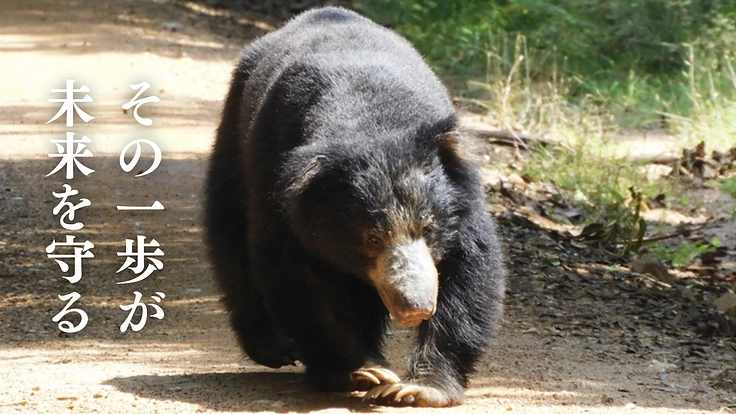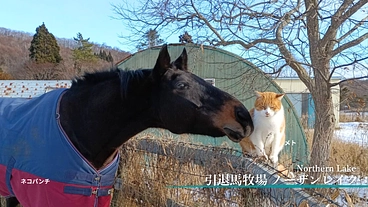寄付総額
目標金額 5,000,000円
- 寄付者
- 469人
- 募集終了日
- 2025年4月18日
本プロジェクトのメンバー紹介
|坪田敏男
(北海道大学獣医学研究院 野生動物学教室 教授・北海道大学総合博物館 館長)
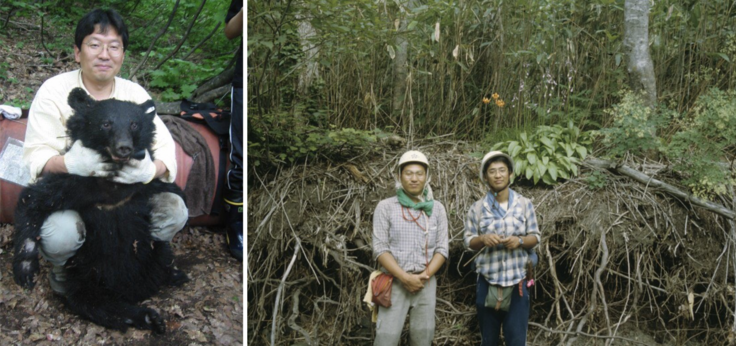
クマと関わり始めて46年にもなりました。北大に入学後、ヒグマ研究グループの一員として北海道のフィールドを歩きながら、少しずつクマという動物の輪郭が掴めてきたように思います。以来、国内外でのクマの調査に関わりながら、クマの魅力に取り憑かれたかもしれません。今回はクマ研究の集大成のつもりで第三弾に挑戦しようと思います。
|下鶴 倫人
(北海道大学大学院獣医学研究院 野生動物学教室 准教授)
クマの生態や身体の仕組みには、まだまだ多くの謎が残されています。私は、知床半島に生息するヒグマの生態研究と、ツキノワグマの冬眠中の生理機構に関する研究を、15年以上続けてきました。
知床半島におけるヒグマの生態研究では、個体モニタリングとDNA解析を併用することで、繁殖行動や個体間の血縁関係、食べ物の季節変化や生存率など、多様な観点からその生態学的特徴を明らかにしてきました。知床では2023年、180頭を超えるヒグマが人の居住地近くに出没し、結果として捕殺されるという、ヒグマにとっても人にとっても非常に大変な事態が生じました。なぜこのような大量出没が生じるのか、どうすればこのような事態を防ぐことができるのか、我々には知らなければならないこと、解決すべき課題が多く残されています。私は、彼らの“真の生き方”について正しい情報を集め、多くの方に知ってもらうことにより、人とクマが北海道において、適切な距離を保ちながら、共に暮らせる社会の実現に貢献したいと考えています。
一方、クマは冬の間冬眠しますが、冬眠中の生理状態には多くの秘密が隠されています。例えば、冬眠中、長期間寝たきりなのにもかかわらず筋肉がほとんど衰えなかったり、骨の強さを保ち続けることができることなど、人間では到底為し得ない仕組みを持っています。謎に包まれた冬眠の仕組みを明らかにできれば、必ずや人や動物の医療に応用可能な画期的発見が得られるものと信じ、研究に取り組んでいます。
| 高畠 千尋
(北海道大学大学院獣医学研究院 野生動物学教室 客員研究員)
北海道に暮らす人々はヒグマに対して根強い「恐怖心」を持っています。人は得体のしれない相手に恐怖を感じますし、ヒグマを科学的に理解していないと、感情的で人間中心的な対策に偏ってしまいます。その結果、昨年は1000頭以上のヒグマが駆除などで命を落としました。これではクマと共存する社会とは到底言えないでしょう。
私は数年前からヒグマの生息地について調査研究をしています。研究を通じてクマの行動データを観察していると、目撃情報が増えているからクマが増えていると判断してよいのだろうか?クマは増えていないけれど、行動範囲が広くなり人に目撃されることが多くなっただけではないか?という疑問を抱いています。野生動物を保全するためには、その動物のことを正しく理解する必要があります。
クマのような大型の高等動物は、データを集めて解析し、その生態を知るためには、多くの人の協力、長い年月、諦めない忍耐力、そしてそれを支える資金が欠かせません。残念なことに日本では、野生動物の調査・研究への資金が非常に乏しく、ツキノワグマやヒグマについてまだまだ分かってないことが多いのです。そして、正しい知識がなければ、正しい付き合い方もできません。
クマを一方的に排除するのではなく、共存の方法を探っていくためにも、科学的知識が不可欠です。私たちの調査研究を続けられるように、そしてクマとの共存のために、どうか皆さんのご寄附をよろしくお願いいたします。
| 羅 暁霏
(北海道大学大学院獣医学院 野生動物学教室 博士課程4年)
【日本ツキノワグマが対象:紡がれる冬眠の真実】
環境が厳しくなる時、ツキノワグマは冬眠に入ることは知られていますが、具体的な特徴までは知らない方が多いかもしれません。ツキノワグマは、12月から春がくるまでの3~4か月もの間、ずっと浅い眠りの状態で、なんと何も食べずに、何も飲まずに、排泄も排尿もしないで過ごしているのです。それに、何も食べなくても体温が落ちず、3~4か月寝続けたあと、骨粗しょう症や尿毒症を患わず、すぐ動け出します。このメカニズムが解明されたら、骨折などで寝込んでいた人や長い時間運動しなかった宇宙飛行士の人もすぐ歩けるようになると期待できます。とても大切な課題です。
|清水 広太郎
(北海道大学大学院獣医学院 野生動物学教室 博士課程4年)
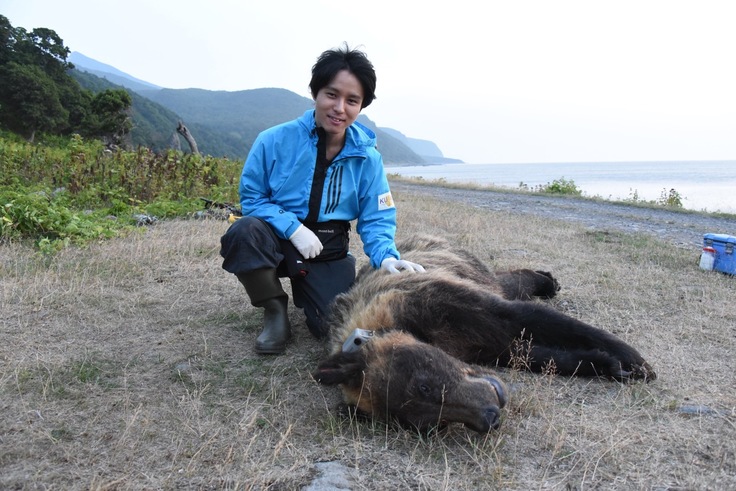
北海道大学野生動物学教室、大学院生の清水です。私は大学でヒグマを対象にしたマダニ媒介性感染症の研究を行っています。
最近、市街地周辺でのヒグマの出没が増加し、人とヒグマの距離が近づくことで感染症のリスクが高まりつつあります。加えて、レジャーブームの拡大によってマダニ媒介性感染症が社会問題となっています。
私たちは、ヒグマによるマダニ媒介性感染症問題に着目し、感染症のリスクを把握し、予防策を講じることで、クマと人間が安全に共生できる環境を創り出すことを目指します。クマと人間が調和して生活できるための新たな知見を得ることで、生態系保全や両者のより良い関係の構築に貢献することができると考えています。
|Anastasiia KOVBA
(北海道大学大学院獣医学院 野生動物学教室 博士課程4年)
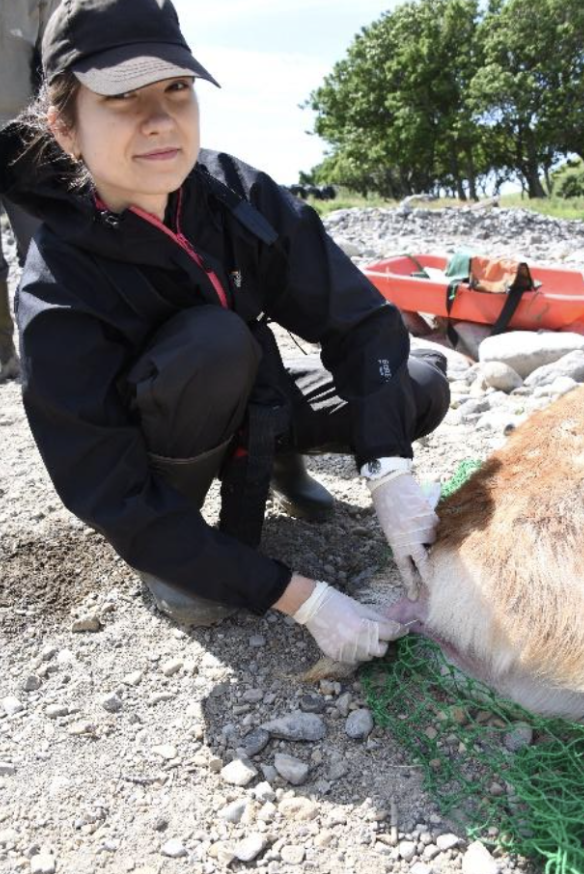
ウクライナからの留学生、博士課程一年生のコウバ・アナスタシアです。
新興感染症や人畜共通感染症の研究、野生生物の保護に興味があり、北海道大学の野生生物医学研究室に所属しました。人・動物・環境の健康(One Health)を守るため、これからも野生動物の感染症の研究を続けたいと思います。
| Rishi Baral
(北海道大学大学院獣医学院 野生動物学教室 博士課程4年)
I am Rishi Baral, a PhD student at Hokkaido University under Professor Toshio Tsubota. I am researching the brown bears studies on the genetic diversity, ecology, and conservation in the Himalayas, Nepal.
Brown bears are a keystone species that play a critical role in the Himalayan ecosystem. However, their populations are declining due to habitat loss, human-wildlife conflict, and climate change. As a researcher, my goal is to understand the unique adaptations of brown bears in the Himalayas and to identify conservation strategies that can help protect this iconic species.
This species is globally least concern and nationally Critically Endangered in Nepal under Criterion C and D in view of a small population which consists of fewer than 20 mature individuals. There is controversy that the species is Himalayan brown bear (U. a. isabellinus) or Tibetan brown bear (U. a. pruinosus). So, I have always been fascinated by the brown bear, particularly their ecological role in the highland ecosystems. Through this research, I aim to understand the genetic diversity, ecology and its co-existing species in these regions and assess their conservation status.
However, conducting field research and genetic analysis can be costly, and I am turning to the community for support. Your contribution to this project will help fund critical research expenses such as field equipment like Camera trapping, GPS as well as laboratory analysis, and field expenses to research site.
I believe that this research will not only provide important insights into the conservation of brown bears in the Himalayas but also inspire greater public appreciation for the value of preserving biodiversity in our world. By contributing to this project, you can be part of a collective effort to protect these magnificent creatures and their unique ecosystem.
In exchange for your support, I will provide regular updates on my research progress and findings and acknowledge your contribution in any resulting publications or presentations. I appreciate your consideration of this crowdfunding campaign and thank you in advance for any support you can provide. Together, we can make a real difference in protecting the brown bears of the Himalayas and their essential role in our planet's ecology.
私は北海道大学の坪田敏男教授の下でPhDの学生、リシ・バラルです。私はネパールのヒマラヤ地域に生息するヒグマに関する、遺伝的多様性、生態、保全に関する研究を行っています。ヒグマはヒマラヤの生態系において重要な役割を果たす重要種でありますが、生息数は生息地の喪失、人獣衝突、気候変動によって減少しています。私は研究者として、ヒマラヤに生息するヒグマの独自の適応力を理解し、この象徴的な種を保護するための保全戦略を確立することを目指しています。
この種はグローバルレッドリスト上では軽度懸念種であり、ネパールでは成熟した個体が20頭未満ということで国内では「C」「D」基準において重大な危険種とされています。また、ヒマラヤヒグマ (U. a. isabellinus) かチベットヒグマ (U. a. pruinosus)かについては論争があります。私は長年にわたり、特に高地生態系における彼らの生態学的役割に魅了されてきました。この研究を通じて、私は遺伝的多様性や共存する種の生態系などを理解し、彼らの保全状況を評価することを目指しています。
しかしながら、現地調査や遺伝子解析は費用がかかるため、コミュニティの皆様の支援を仰いでいます。皆様の貢献によって、カメラトラップやGPSなどの現地調査に必要な機材、実験室分析、調査地への移動費など、重要な研究費用を賄うことができます。
| Joshaniel Tan
(北海道大学大学院獣医学院 野生動物学教室 博士課程3年)

The increasing presence of Mercury (Hg) in the bodies of living organisms remains a health concern to wildlife. Mercury is emitted from both natural and anthropogenic sources, with power plants fueled by fossil fuels and gold mining contributing the largest proportion. The heavy metal can persist in the bodies of wildlife and bioaccumulates up the food chain, becoming concentrated in the highest amounts at the top of the chain. This can have health implications for apex predators such as grizzly bears, which can result in complications with decreased gut microbiome diversity and immune and neurological systems.
The brown bear is a keystone species in Hokkaido, Japan, with the largest population observed in Shiretoko National Park (SNP). This population has been found to consume high levels of Japanese stone pine nuts and salmonoid fish during the annual spawning season.
Amongst them, there are varying levels of consumption of salmon between both regions and individuals, with some regions of SNP that have lower levels of human population and habitat conversion supporting higher levels of consumption. As salmon in the surrounding region of the Sea of Okhotsk and the Bering Sea have been found to possess high levels of mercury bioaccumulation, it has become imperative to establish a baseline of mercury levels in this population of brown bears and track any potential changes over time.
It is also possible that some individuals rely on beached marine animal carcasses during the early summer months when food sources are scarce, however the level of dependence has not yet been established. Although diet can be established through other methods such as stable isotope analysis, this method requires many more hairs for processing and does not detect the presence of mercury, which would then not reflect the same health implications.
|中村 汐里
(北海道大学大学院獣医学院 野生動物学教室 博士課程3年)
現在、私は博士課程において、DNAを用いたクマ類の年齢推定法の開発と、クマ類の冬眠制御機構の解明に取り組んでいます。DNAによる年齢推定法は、個体群動態の把握などを通してクマ類と人間の共存に役立てることができると考えています。また、他の冬眠動物と全く異なる特性を示すクマ類の冬眠研究は、ヒトの医療や生物学の分野に革新的な進歩をもたらす可能性があります。
当研究室では、知床半島国立公園内に生息する野生ヒグマ個体群を対象に25年以上にわたって生態調査を継続しており、また、国内のクマ飼育施設との共同研究の経験も豊富で、海外のクマ類の研究にも積極的に取り組んできております。そのため、クマ類の生理、生態および感染症に関する研究を幅広く遂行できる世界でも類を見ない研究体制が整っています。私たちの研究がより多くの人々や環境、そしてクマ類に貢献できるよう、引き続き皆さまからのご寄附とご協力を心よりお願い申し上げます。
|Saman Kumara
(北海道大学大学院獣医学院 野生動物学教室 博士課程3年)
I’m Saman, a doctoral student at the Graduate School of Veterinary Medicine, Hokkaido University, in the Laboratory of Wildlife Biology and Medicine. My research focuses on sloth bear genetics and elephant tuberculosis in Sri Lanka under the guidance of Professor Toshio Tsubota and Associate Professor Michito Shimozuru.
The Sri Lankan sloth bear (Melursus ursinus inornatus) is a subspecies of the sloth bear, endemic to Sri Lanka. It primarily inhabits dry zone forests and is well adapted to a nocturnal and crepuscular lifestyle.The Sri Lankan sloth bear faces several significant threats that have led to its declining population. The primary threats include, habitat loss and fragmentation, human-wildlife conflict, poaching and Illegal wildlife trade, climate change and food scarcity, roadkill and accidents. As a result, currently less than 1000 individuals are remaining in the wild.
Regarding the conservation efforts, the Sri Lankan sloth bear is classified as Vulnerable by the IUCN.
Conservation efforts include habitat protection through national parks and wildlife reserves, human-wildlife conflict mitigation strategies, and awareness programs to promote coexistence. Strengthening wildlife laws and enforcing anti-poaching measures are also crucial for their survival.
Funding for the protection of the Sri Lankan sloth bear is crucial to ensuring its survival. Financial support can help conserve and restore its natural habitat, implement effective anti-poaching measures, and reduce human-wildlife conflict through community-based initiatives. Investing in research and monitoring programs will provide valuable data to guide conservation strategies. Additionally, awareness campaigns and eco-tourism projects can generate sustainable income while promoting the coexistence of local communities with sloth bears. Protecting this unique species requires collective efforts, and dedicated funding will play a key role in securing its future.
We would also like to thank everyone who supported protecting other bear species by giving your support hands. Thank you for considering crowdfunding. Thank you for your continued support.
ギフト
3,000円+システム利用料

【個人向け】3,000円コース
<返礼内容>
・お礼のメール
・活動報告レポート(2026年3月)
上記に加えて、以下の謝意をお送りいたします。
<北大フロンティア基金からのギフト>
・寄附金領収書 ※
・北大フロンティア基金からの御礼( https://www.hokudai.ac.jp/fund/gratitude/ )
・銘板の掲出(北大フロンティア基金への寄附累計20万円達成時)
※寄附金領収書は2025年7月末までに送付します。なお、領収書の日付は、READYFORから北海道大学に入金のある2025年6月10日の日付となります。
- 申込数
- 216
- 在庫数
- 制限なし
- 発送完了予定月
- 2026年3月
10,000円+システム利用料

【個人向け】10,000円コース
<返礼内容>
・お礼のメール
・活動報告レポート(2026年3月)
・ステッカー
・クマの画像
・オンラインサイエンスカフェ
※2025年12月頃に実施予定/日程等詳細は1ヶ月前までにご連絡予定
上記に加えて、以下の謝意をお送りいたします。
<北大フロンティア基金からのギフト>
・寄附金領収書 ※
・北大フロンティア基金からの御礼( https://www.hokudai.ac.jp/fund/gratitude/ )
・銘板の掲出(北大フロンティア基金への寄附累計20万円達成時)
※寄附金領収書は2025年7月末までに送付します。なお、領収書の日付は、READYFORから北海道大学に入金のある2025年6月10日の日付となります。
- 申込数
- 226
- 在庫数
- 制限なし
- 発送完了予定月
- 2026年3月
3,000円+システム利用料

【個人向け】3,000円コース
<返礼内容>
・お礼のメール
・活動報告レポート(2026年3月)
上記に加えて、以下の謝意をお送りいたします。
<北大フロンティア基金からのギフト>
・寄附金領収書 ※
・北大フロンティア基金からの御礼( https://www.hokudai.ac.jp/fund/gratitude/ )
・銘板の掲出(北大フロンティア基金への寄附累計20万円達成時)
※寄附金領収書は2025年7月末までに送付します。なお、領収書の日付は、READYFORから北海道大学に入金のある2025年6月10日の日付となります。
- 申込数
- 216
- 在庫数
- 制限なし
- 発送完了予定月
- 2026年3月
10,000円+システム利用料

【個人向け】10,000円コース
<返礼内容>
・お礼のメール
・活動報告レポート(2026年3月)
・ステッカー
・クマの画像
・オンラインサイエンスカフェ
※2025年12月頃に実施予定/日程等詳細は1ヶ月前までにご連絡予定
上記に加えて、以下の謝意をお送りいたします。
<北大フロンティア基金からのギフト>
・寄附金領収書 ※
・北大フロンティア基金からの御礼( https://www.hokudai.ac.jp/fund/gratitude/ )
・銘板の掲出(北大フロンティア基金への寄附累計20万円達成時)
※寄附金領収書は2025年7月末までに送付します。なお、領収書の日付は、READYFORから北海道大学に入金のある2025年6月10日の日付となります。
- 申込数
- 226
- 在庫数
- 制限なし
- 発送完了予定月
- 2026年3月

JWCサポーター大募集中!傷付いた野生動物を救いたい
- 総計
- 253人

救う命を選ばない。どんな犬猫も保護し続け福岡の里親さんを増やしたい
#動物
- 現在
- 3,003,000円
- 支援者
- 282人
- 残り
- 1日

絶滅の危機に瀕しているシマアオジ 彼らのいる景色を取り戻したい
#国際協力
- 現在
- 4,166,400円
- 寄付者
- 343人
- 残り
- 17時間

クマたちから学ぶ日本再生プロジェクト!
- 総計
- 49人

国立科学博物館マンスリーサポーター|地球の宝を守りつづける
- 総計
- 679人

絶滅危惧種ツシマヤマネコを守るために!月々のご支援で安定的な整備を
- 総計
- 147人

老病ねこたちが最後まで安心して過ごせるおうちを守っていきたい!
- 現在
- 1,913,000円
- 支援者
- 144人
- 残り
- 8日
カップ麺の新たな幕開け専用アイテム!
- 支援総額
- 143,000円
- 支援者
- 20人
- 終了日
- 7/15

Keio Fashion Creator 製作活動ご支援のお願い
- 支援総額
- 445,000円
- 支援者
- 41人
- 終了日
- 11/15

京料理 西陣萬重で心尽くしの特別な体験を
- 支援総額
- 1,211,000円
- 支援者
- 47人
- 終了日
- 12/26
総社市から全国へ!オートバイレースで日本一への挑戦。
- 支援総額
- 1,300,000円
- 支援者
- 51人
- 終了日
- 1/31
重症障害児に、夢と希望溢れるパジャマを!一緒に未来を語れるパジャマ
- 支援総額
- 1,215,000円
- 支援者
- 75人
- 終了日
- 10/4

盲重複障がい児と家族を支える、生活介護施設に応援のお力を!
- 支援総額
- 539,000円
- 支援者
- 45人
- 終了日
- 10/13

画文集「昭和の原風景」を作りたい!あなたに届けたい昭和の記憶
- 支援総額
- 1,105,000円
- 支援者
- 24人
- 終了日
- 7/31

